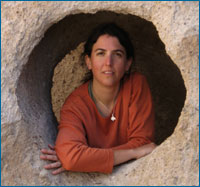The work of Chelsea Specht
by the Understanding Evolution team

When Dr. Chelsea Specht decided to go into biology, she expected to wind up in a white lab coat with a stethoscope around her neck. Instead, she skipped med school, went to New York University for a PhD — and found herself interviewing indigenous peoples in South America, conserving the Amazon rainforest with the World Wildlife Fund, and trekking through the jungles of Bolivia and Peru searching for rare plants. This work eventually led her to her current job. As a professor at UC Berkeley, Chelsea studies the evolution of ginger plants in order to better understand how they diversified — and ultimately, how to protect them and other species from going extinct. As Chelsea puts it, “The more we can understand about diversification, the more we can understand about extinction.”
In this research profile, we will explore these key questions:
- How are phylogenies useful for classification?
- Why do some distantly related species look remarkably similar to one another?
- What is the principle of parsimony?
- What is an adaptive radiation?
- How do scientists study adaptive radiations?
Get tips for using research profiles, like this one, with your students.
